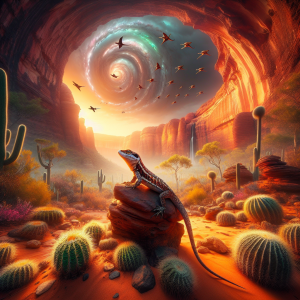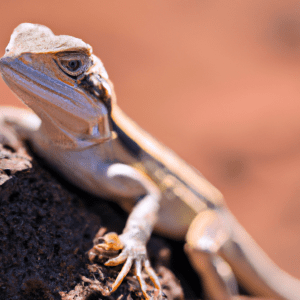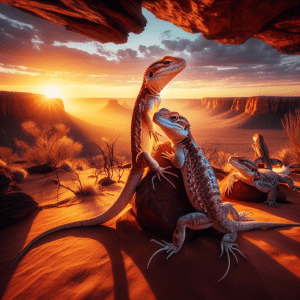Introduction to Outback Lizards Research Expeditions
Imagine diving into the fascinating world of outback lizards during research expeditions – it’s truly an adventure like no other! Picture yourself surrounded by the vast expanse of the Australian outback, with its red sands stretching as far as the eye can see. The air is filled with a sense of excitement and anticipation as you gear up to embark on a journey of discovery.
As we delve into the realm of outback lizards, one can’t help but marvel at the incredible diversity of species that call this harsh environment home. From the iconic bearded dragons to the elusive thorny devils, each lizard species has adapted uniquely to survive in this rugged landscape.
An interesting fact that might surprise you is that outback lizards play a crucial role in maintaining the delicate balance of their ecosystem. They are not just fascinating creatures to study but also key indicators of environmental health. By understanding their behaviors, habitats, and interactions, researchers can gain valuable insights into the overall well-being of the outback ecosystem.
Just imagine the thrill of encountering these captivating reptiles in their natural habitat, observing their intricate behaviors, and documenting their movements. Every research expedition brings new challenges and opportunities to learn, pushing you to expand your knowledge and skills in the field of herpetology.
So, are you ready to embark on a journey of discovery and unravel the mysteries of outback lizards? Stay tuned as we explore the importance of studying these fascinating creatures, the top species to look out for, and the planning and tools needed for a successful research expedition. Get ready to immerse yourself in the awe-inspiring world of outback lizards – it’s a wild ride you won’t want to miss!
Importance of Studying Outback Lizards
Have you ever stopped to think about the fascinating world of outback lizards and why studying them is so important? Well, let me tell you a little story that might pique your interest.
I remember the first time I went on a research expedition to study outback lizards. It was a scorching hot day in the Australian desert, and as I observed these incredible creatures in their natural habitat, I was struck by the sheer diversity and beauty of the lizard species I encountered. From the vibrant colors of the central netted dragons to the camouflaged patterns of the thorny devils, each lizard had its own unique characteristics that made them so captivating to study.
You see, studying outback lizards is not just about admiring their beauty; it’s also crucial for understanding the delicate balance of ecosystems in the Australian outback. These lizards play a vital role in the food chain, controlling insect populations and serving as prey for larger predators. By studying them, researchers can gain valuable insights into the health of the environment and the impact of human activities on these fragile ecosystems.
But it’s not just about conservation; studying outback lizards can also provide us with valuable information about evolutionary biology and adaptation. These resilient creatures have adapted to survive in some of the harshest environments on earth, and by studying them, we can learn more about how species evolve and adapt to changing conditions over time.
So, next time you see a lizard darting across the desert sands, take a moment to appreciate the intricate beauty and complexity of these fascinating creatures. Who knows what secrets they might hold and what lessons we can learn from them?
Top Outback Lizard Species to Explore
Have you ever wondered about the diverse and fascinating lizard species that call the Australian outback home? Let me tell you, exploring the top outback lizard species is like stepping into a captivating world of unique reptilian wonders.
Picture this: you’re trekking through the rugged terrain of the outback, surrounded by the vast expanse of red earth and ancient landscapes. As you navigate through this untamed wilderness, you come across the iconic Thorny Devil, a master of camouflage with its spiny body and incredible ability to blend into its surroundings. This encounter will surely leave you in awe of the intricate adaptations these lizards have evolved to survive in such harsh environments.
Now, here’s an interesting fact for you: did you know that the Perentie, Australia’s largest monitor lizard, can grow up to 2 meters in length and is known for its impressive speed and agility? Imagine witnessing this majestic creature in action as it moves gracefully through the outback, showcasing its predatory prowess.
Exploring the top outback lizard species is not just about observing these creatures from a distance; it’s about gaining a deeper understanding of their behaviors, habitats, and ecological roles. By immersing yourself in the world of outback lizards, you’ll discover the intricate interconnectedness of these reptiles with their environment and the importance of conserving their delicate ecosystems.
So, the next time you embark on a research expedition in the outback, keep an eye out for the iconic Thorny Devil, the majestic Perentie, and other fascinating lizard species that make this rugged landscape their home. Who knows what other wonders you might uncover as you delve deeper into the captivating world of outback lizards!
Planning a Successful Research Expedition
You know, when it comes to embarking on a research expedition to study outback lizards, planning is key. Picture this: you’re out in the vast expanse of the Australian outback, surrounded by the rugged beauty of the landscape, and you’re on a mission to uncover the secrets of these fascinating reptiles. Exciting, right?
Now, let’s delve into the nitty-gritty of planning such an expedition. One practical tip that I’ve found essential is to meticulously plan your logistics. From transportation to accommodation to research equipment, every detail matters when you’re venturing into the outback. It’s all about being prepared for the unexpected and ensuring a smooth research experience.
Another crucial aspect to consider is safety. The outback can be a harsh and remote environment, so it’s vital to have contingency plans in place. From first aid supplies to communication devices, ensuring the safety of your team should be a top priority. It’s all about balancing adventure with responsibility.
And here’s an interesting fact for you: did you know that outback lizards have evolved unique adaptations to survive in the arid conditions of the Australian desert? From camouflage techniques to temperature regulation mechanisms, these creatures are true marvels of nature. Studying them up close during your expedition can provide valuable insights into their behavior and ecology.
As you plan your research expedition, consider the broader significance of your work. By studying outback lizards, you’re not just unraveling the mysteries of one species but also contributing to our understanding of ecosystem dynamics and biodiversity conservation. Your efforts can have a tangible impact on scientific research and environmental stewardship.
So, as you gear up for your outback adventure, remember that careful planning, a focus on safety, and a sense of curiosity are your best companions. Here’s to a successful research expedition filled with discovery and wonder in the captivating world of outback lizards!
Tools and Techniques for Studying Outback Lizards
Have you ever wondered how researchers study lizards in the vast Australian outback? It’s like being a detective in a wild and fascinating world! One of the key aspects of studying outback lizards is knowing the right tools and techniques to gather data and observe these amazing creatures in their natural habitats.
Imagine trekking through the rugged outback, equipped with binoculars, GPS devices, and cameras to document the behavior and habitat preferences of different lizard species. These tools are essential for researchers to collect accurate data and track the movements of lizards across the vast terrain.
But it’s not just about the tools – researchers also use various techniques to study outback lizards. From setting up camera traps to capture elusive species on film to conducting meticulous field surveys to document lizard populations, each method plays a crucial role in understanding the ecology and behavior of these reptiles.
An interesting fact about studying outback lizards is that researchers often have to adapt their methods to the harsh and unpredictable conditions of the Australian outback. Extreme temperatures, rugged terrain, and limited resources can pose challenges, making it essential for researchers to be resourceful and flexible in their approach.
For aspiring researchers or wildlife enthusiasts, a practical tip when studying outback lizards is to be patient and observant. Lizards are masters of camouflage and can easily blend into their surroundings, so keen observation skills are key to spotting these elusive creatures in the wild.
By mastering the tools and techniques of studying outback lizards, researchers can uncover valuable insights into the ecology, behavior, and conservation of these fascinating reptiles. So, next time you venture into the outback, keep an eye out for these amazing creatures and appreciate the dedicated efforts of researchers working to unravel their secrets.
Challenges Faced During Research Expeditions
Imagine we’re out in the vast Australian outback, surrounded by the rugged beauty of the landscape. We’re on a research expedition, studying the fascinating world of outback lizards. Now, let me tell you about some of the challenges we face during these expeditions.
One of the biggest challenges we encounter is the unpredictable nature of the outback environment. The harsh climate, remote locations, and rugged terrain can make conducting research on lizards quite challenging. From scorching temperatures to sudden weather changes, we have to be prepared for anything nature throws our way.
Picture this – we’re out in the field, setting up our equipment to observe a particular species of lizard. Just as we’re about to start our observations, a sudden dust storm sweeps through the area, making it almost impossible to see or work. These unexpected challenges test our resilience and adaptability, requiring us to think on our feet and come up with creative solutions.
Despite the challenges, these experiences also teach us valuable lessons and make the research expeditions all the more rewarding. Overcoming obstacles in the field not only adds excitement to the adventure but also deepens our understanding of outback lizards and their unique ecosystem.
So, next time you think about embarking on a research expedition in the outback to study lizards, remember to be prepared for the unexpected. Embrace the challenges, learn from them, and revel in the thrill of exploring the untamed beauty of the outback while unraveling the mysteries of these incredible creatures.
Discoveries and Insights from Past Expeditions
Imagine standing in the vast expanse of the Australian outback, the sun beating down on your back as you carefully observe a lizard darting across the red earth. This moment captures the essence of the incredible discoveries and insights that have emerged from past research expeditions focused on outback lizards.
One interesting fact about these expeditions is that researchers have uncovered a wealth of information about the unique behaviors, adaptations, and ecological roles of outback lizard species. Through their dedicated efforts, scientists have gained a deeper understanding of how these fascinating creatures survive and thrive in the harsh outback environment.
As we delve into the discoveries and insights from past expeditions, it’s fascinating to learn about the intricate relationships between outback lizards and their surroundings. Did you know that certain lizard species play crucial roles in maintaining ecosystem balance by controlling insect populations or serving as prey for larger predators?
These research expeditions have not only shed light on the biology and behavior of outback lizards but have also highlighted the importance of preserving their habitats and ecosystems. The knowledge gained from these studies can inform conservation efforts and help protect these unique species for future generations to appreciate and study.
So, the next time you spot a lizard scurrying across the outback landscape, take a moment to appreciate the wealth of information and insights that researchers have uncovered through their dedicated expeditions. Who knows what new discoveries await as we continue to explore the captivating world of outback lizards?
Future Prospects in Outback Lizard Research
Have you ever thought about the future prospects in outback lizard research? It’s quite fascinating when you delve into the possibilities that lie ahead in this field. Imagine the potential for new discoveries, innovative research methodologies, and conservation efforts that could stem from ongoing research expeditions into the outback.
One interesting aspect to consider is how technology is shaping the future of outback lizard research. With advancements in tools such as GPS tracking devices, drones for aerial surveys, and genetic analysis techniques, researchers are now equipped with a powerful arsenal to study these elusive creatures more effectively. These technological advancements not only enhance the accuracy of data collection but also open up new avenues for studying the behavior, habitat preferences, and genetic diversity of outback lizard species.
Beyond the technical aspects, the future prospects in outback lizard research also raise questions about the conservation and management of these unique species. As our understanding of outback lizards grows, so does the urgency to protect their habitats and ensure their survival in the face of environmental challenges. How can we translate research findings into actionable conservation strategies? What role can citizen science initiatives play in monitoring lizard populations and contributing to research efforts?
The future of outback lizard research holds immense potential for scientific breakthroughs, conservation initiatives, and educational outreach programs. By engaging with this field, researchers and enthusiasts alike have the opportunity to make meaningful contributions to our understanding of outback ecosystems and the conservation of lizard species. So, let’s embark on this exciting journey together and explore the endless possibilities that await us in the world of outback lizard research!
Joining a Research Expedition: How to Get Involved
Have you ever thought about joining a research expedition to study outback lizards? It’s a thrilling opportunity to immerse yourself in the world of these fascinating creatures and contribute to scientific discovery.
Picture this: you’re out in the vast Australian outback, surrounded by the red desert landscape and the unique wildlife that calls it home. You’re part of a team of passionate researchers, all working together to unravel the mysteries of outback lizard species. From monitoring behavior to collecting data on habitat preferences, every moment on a research expedition is filled with excitement and learning.
If you’re considering joining a research expedition, here’s a practical tip: start by researching organizations or universities that offer opportunities in outback lizard research. Look for programs that align with your interests and expertise, whether you’re a seasoned biologist or a budding field researcher. By choosing the right expedition, you can make the most of your experience and contribute meaningfully to scientific knowledge.
Joining a research expedition isn’t just about studying lizards; it’s also about connecting with like-minded individuals, learning new skills, and expanding your horizons. The friendships you form and the memories you create during these expeditions can last a lifetime. Plus, the insights and discoveries you contribute to can have far-reaching implications for conservation efforts and biodiversity research.
So, why not take the leap and immerse yourself in the world of outback lizards? Whether you’re a seasoned researcher or a curious explorer, there’s so much to gain from being part of a research expedition. Who knows what wonders you might uncover and what impact you could have on the field of herpetology? The adventure awaits!
Conclusion: Embracing the Fascinating World of Outback Lizards
When it comes to joining a research expedition focused on outback lizards, it’s not just about exploring the wilderness—it’s about immersing yourself in a world filled with fascinating discoveries and unique experiences. Being part of such an expedition can truly be a life-changing opportunity, allowing you to witness the wonders of nature up close and contribute to valuable scientific research.
Imagine embarking on a journey to the remote Australian outback, surrounded by vast landscapes and diverse wildlife. As you delve into the world of outback lizards, every moment becomes a learning experience, from observing their behavior in their natural habitat to studying their intricate adaptations for survival.
One practical tip I can share with you is to always be prepared for the unexpected when venturing into the outback. The remote and rugged terrain can present challenges, but with proper planning and the right gear, you can navigate through the wilderness with confidence. Make sure to pack essentials such as water, sunscreen, sturdy footwear, and field equipment to ensure a successful and safe expedition.
Engaging in outback lizard research not only offers a chance to uncover the mysteries of these fascinating creatures but also provides valuable insights into the ecosystem as a whole. By studying the interactions between lizards and their environment, researchers can gain a deeper understanding of biodiversity, conservation, and the impacts of environmental changes.
So, if you’re ready to dive into the world of outback lizards and embark on a thrilling research expedition, the opportunities are endless. Whether you’re a seasoned scientist or an aspiring explorer, there’s always something new to discover and learn in the captivating realm of outback lizard research. Are you prepared to take on the challenge and experience the magic of the Australian outback firsthand?




